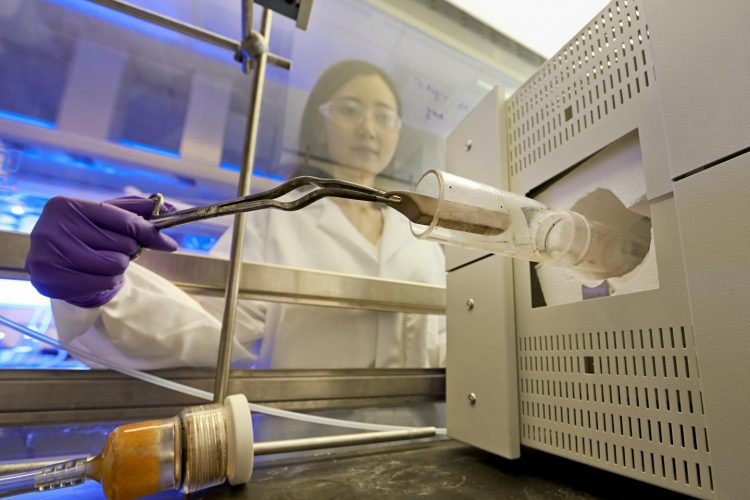New nontoxic process promises larger ultrathin sheets of 2-D nanomaterials

ORNL's Huiyuan Zhu places a sample of boron nitride, or "white graphene," into a furnace as part of a novel, nontoxic gas exfoliation process to separate 2-D nanomaterials. Credit: ORNL
“It's actually a very simple procedure,” said ORNL chemist Huiyuan Zhu, who co-authored a study published in Angewandte Chemie International Edition. “We heated commercially available boron nitride in a furnace to 800 degrees Celsius to expand the material's 2D layers. Then, we immediately dipped the material into liquid nitrogen, which penetrates through the interlayers, gasifies into nitrogen, and exfoliates, or separates, the material into ultrathin layers.”
Nanosheets of boron nitride could be used in separation and catalysis, such as transforming carbon monoxide to carbon dioxide in gasoline-powered engines. They also may act as an absorbent to mop up hazardous waste. Zhu said the team's controlled gas exfoliation process could be used to synthesize other 2D nanomaterials such as graphene, which has potential applications in semiconductors, photovoltaics, electrodes and water purification.
Because of the versatility and commercial potential of one-atom-thick 2D nanomaterials, scientists are seeking more efficient ways to produce larger sheets. Current exfoliation procedures use harsh chemicals that produce hazardous byproducts and reduce the amount of surface area per nanosheet, Zhu said.
“In this particular case, the surface area of the boron nitride nanosheets is 278 square meters per gram, and the commercially available boron nitride material has a surface area of only 10 square meters per gram,” Zhu said. “With 20 times more surface area, boron nitride can be used as a great support for catalysis.”
Further research is planned to expand the surface area of boron nitride nanosheets and also test their feasibility in cleaning up engine exhaust and improving the efficiency of hydrogen fuel cells.
###
Along with Zhu, several co-authors participated in the paper, “Controlled Gas Exfoliation of Boron Nitride into Few-Layered Nanosheets,” including ORNL's Sheng Dai, Xiang Gao, Qian Li, Shannon M. Mahurin and Wenshuai Zhu; Yanhong Chao, Hongping Li and Huaming Li with Jiangsu University and Meijun Li from the University of Tennessee. The Angewandte Chemie study can be found here.
The study was supported by the DOE Office of Science. Additional funding was provided by the Liane Russell Distinguished Early Career Fellowship through the Laboratory Directed Research and Development program. Zhu joined ORNL in 2014 as one of the lab's first Russell Fellows, and her primary area of research is on synthetic control of hybrid nanomaterials for catalytic applications.
ORNL is managed by UT-Battelle for the Department of Energy's Office of Science, the single largest supporter of basic research in the physical sciences in the United States. DOE's Office of Science is working to address some of the most pressing challenges of our time. For more information, please visit http://science.
Image 1: https:/
Cutline 1: ORNL's Huiyuan Zhu places a sample of boron nitride, or “white graphene,” into a furnace as part of a novel, nontoxic gas exfoliation process to separate 2D nanomaterials.
Image 2: https:/
Cutline 2: A new ORNL study published in Angewandte Chemie International Edition describes a new gas exfoliation process that yields a 20 percent increase in surface area per nanosheet of boron nitride. (Image credit: Angewandte Chemie International Edition.)
NOTE TO EDITORS: You may read other press releases from Oak Ridge National Laboratory or learn more about the lab at http://www.
Twitter – http://twitter.
RSS Feeds – http://www.
Flickr – http://www.
YouTube – http://www.
LinkedIn – http://www.
Facebook – http://www.
Media Contact
All latest news from the category: Materials Sciences
Materials management deals with the research, development, manufacturing and processing of raw and industrial materials. Key aspects here are biological and medical issues, which play an increasingly important role in this field.
innovations-report offers in-depth articles related to the development and application of materials and the structure and properties of new materials.
Newest articles

Properties of new materials for microchips
… can now be measured well. Reseachers of Delft University of Technology demonstrated measuring performance properties of ultrathin silicon membranes. Making ever smaller and more powerful chips requires new ultrathin…

Floating solar’s potential
… to support sustainable development by addressing climate, water, and energy goals holistically. A new study published this week in Nature Energy raises the potential for floating solar photovoltaics (FPV)…

Skyrmions move at record speeds
… a step towards the computing of the future. An international research team led by scientists from the CNRS1 has discovered that the magnetic nanobubbles2 known as skyrmions can be…





















